Have you tried to open a well-known web site and found that your internet browser is redirected to a previously unseen site called Microsoft.com.cdn.pcsaver3.win offering install an questionable software to update your drivers? If you answered ‘Yes’ then your need to know that your personal computer can be infected with an adware (also known as ‘ad-supported’ software). The ad-supported software is a type of harmful software that alters your personal computer’s web-browser settings so that you will be randomly rerouted to an unwanted ads including misleading advertising like Microsoft.com.cdn.pcsaver3.win pop-up warnings. You need to follow the steps below ASAP. It’ll clean your PC from the adware and thereby remove Microsoft.com.cdn.pcsaver3.win pop-up ads. Moreover, the step by step instructions will allow you to protect your computer from more malicious viruses and trojans.

http://microsoft.com.cdn.pcsaver3.win/newlander/microsoftwarningx.html
What is more, the ad supported software may display ads depend on a web site that you are visiting. That is, it’s clear that this ad-supported software, without your permission, steals your private information such as: your ip address, what is a web page you are viewing now, what you are looking for on the Internet, which links you are clicking, and much, much more. The ‘ad supported’ software may monetize its functionality by collecting data from your browsing sessions and selling it to third party companies. This puts your personal information at a security risk.
Most often, the adware affects the most common internet browsers such as the Google Chrome, Microsoft Internet Explorer, Firefox and Edge. But such the malicious software as well may infect another web-browsers by changing its shortcuts (adding an argument like ‘http://site.address’ into Target field of a web-browser’s shortcut). So every time you run the web-browser, it will redirect to the unwanted Microsoft.com.cdn.pcsaver3.win web site. Even if you setup a new startpage, an annoying web site will be the first thing you see when you open the Chrome, Firefox, Internet Explorer and Microsoft Edge.
We recommend to remove the adware that cause misleading Microsoft.com.cdn.pcsaver3.win popup scam to appear, as soon as you found this problem, as it can direct you to web-resources that may load other malicious software on your machine.
Remove Microsoft.com.cdn.pcsaver3.win pop-up warning
As with deleting adware, malware or PUPs, there are few steps you may do. We advise trying them all. If you do only one part of the guidance, then it should be run malicious software removal utility, because it should get rid of ad supported software and block any further infection. But to completely remove Microsoft.com.cdn.pcsaver3.win pop-up you’ll have to at least reset your browser settings such as homepage, new tab and search provider by default to default state, disinfect PC’s browsers shortcuts, delete all unwanted and suspicious programs, and remove ‘ad supported’ software by malware removal tools. Certain of the steps below will require you to close this web-page. So, please read the step by step tutorial carefully, after that bookmark or print it for later reference.
How to delete Microsoft.com.cdn.pcsaver3.win pop-up without any software
These steps to delete Microsoft.com.cdn.pcsaver3.win pop up scam without any programs are presented below. Be sure to carry out the step-by-step guide completely to fully remove this adware which causes misleading Microsoft.com.cdn.pcsaver3.win pop-up on your internet browser.
Remove Microsoft.com.cdn.pcsaver3.win related programs through the Control Panel of your computer
First, go to Windows Control Panel and delete suspicious programs, all applications you do not remember installing. It’s important to pay the most attention to applications you installed just before Microsoft.com.cdn.pcsaver3.win popup scam appeared on your web browser. If you don’t know what a program does, look for the answer on the Web.
Press Windows button ![]() , then click Search
, then click Search ![]() . Type “Control panel”and press Enter. If you using Windows XP or Windows 7, then press “Start” and select “Control Panel”. It will show the Windows Control Panel as displayed in the following example.
. Type “Control panel”and press Enter. If you using Windows XP or Windows 7, then press “Start” and select “Control Panel”. It will show the Windows Control Panel as displayed in the following example.

Further, press “Uninstall a program” ![]()
It will display a list of all software installed on your system. Scroll through the all list, and uninstall any suspicious and unknown programs.
Get rid of unwanted Scheduled Tasks
Once installed, the adware can add a task in to the Windows Task Scheduler Library. Due to this, every time when you boot your computer, it will display Microsoft.com.cdn.pcsaver3.win undesired web-page. So, you need to check the Task Scheduler Library and remove all harmful tasks which have been created by ‘ad-supported’ application.
Press Windows and R keys on your keyboard together. It will show a prompt which titled with Run. In the text field, type “taskschd.msc” (without the quotes) and click OK. Task Scheduler window opens. In the left-hand side, press “Task Scheduler Library”, as shown in the following example.
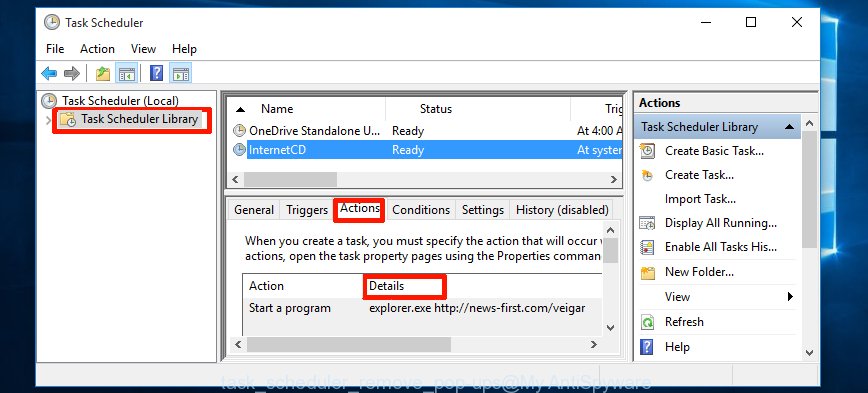
Task scheduler, list of tasks
In the middle part you will see a list of installed tasks. Select the first task, its properties will be open just below automatically. Next, click the Actions tab. Necessary to look at the text which is written under Details. Found something like “explorer.exe http://site.address” or “chrome.exe http://site.address” or “firefox.exe http://site.address”, then you need remove this task. If you are not sure that executes the task, then google it. If it is a component of the malicious program, then this task also should be removed.
Further click on it with the right mouse button and select Delete as displayed in the figure below.

Task scheduler, delete a task
Repeat this step, if you have found a few tasks that have been created by malicious application. Once is finished, close the Task Scheduler window.
Remove Microsoft.com.cdn.pcsaver3.win pop up warning from Microsoft Internet Explorer
If you find that IE internet browser settings like start page, new tab page and default search provider having been modified by adware that shows misleading Microsoft.com.cdn.pcsaver3.win pop-up warning on your machine, then you may revert back your settings, via the reset web-browser procedure.
First, launch the Internet Explorer. Next, click the button in the form of gear (![]() ). It will display the Tools drop-down menu, click the “Internet Options” as shown below.
). It will display the Tools drop-down menu, click the “Internet Options” as shown below.

In the “Internet Options” window click on the Advanced tab, then click the Reset button. The Internet Explorer will show the “Reset Internet Explorer settings” window as shown below. Select the “Delete personal settings” check box, then press “Reset” button.

You will now need to restart your system for the changes to take effect.
Remove Microsoft.com.cdn.pcsaver3.win from Firefox by resetting internet browser settings
If your Mozilla Firefox browser is rerouted to Microsoft.com.cdn.pcsaver3.win without your permission or an unknown search engine shows results for your search, then it may be time to perform the internet browser reset.
First, launch the Firefox. Next, click the button in the form of three horizontal stripes (![]() ). It will display the drop-down menu. Next, click the Help button (
). It will display the drop-down menu. Next, click the Help button (![]() ).
).

In the Help menu click the “Troubleshooting Information”. In the upper-right corner of the “Troubleshooting Information” page click on “Refresh Firefox” button like below.

Confirm your action, press the “Refresh Firefox”.
Remove Microsoft.com.cdn.pcsaver3.win pop-up scam from Chrome
If your Google Chrome web-browser is rerouted to intrusive Microsoft.com.cdn.pcsaver3.win page, it may be necessary to completely reset your web browser program to its default settings.

- First start the Chrome and click Menu button (small button in the form of three horizontal stripes).
- It will show the Google Chrome main menu. Select “Settings” option.
- You will see the Chrome’s settings page. Scroll down and click “Show advanced settings” link.
- Scroll down again and click the “Reset settings” button.
- The Google Chrome will open the reset profile settings page as on the image above.
- Next click the “Reset” button.
- Once this task is done, your browser’s home page, new tab and default search provider will be restored to their original defaults.
- To learn more, read the post How to reset Google Chrome settings to default.
Fix web browser shortcuts, altered by ‘ad supported’ software
Important to know, most anti malware applications that are able to get rid of ad-supported software, but unable to detect and recover modified shortcuts. So, you need to fix the desktop shortcuts for your Google Chrome, Firefox, MS Edge and Internet Explorer web browsers manually.
Open the properties of the web-browser shortcut. Right click on the shortcut of infected internet browser and choose the “Properties” option and it’ll show the properties of the shortcut. Next, choose the “Shortcut” tab and have a look at the Target field as on the image below.
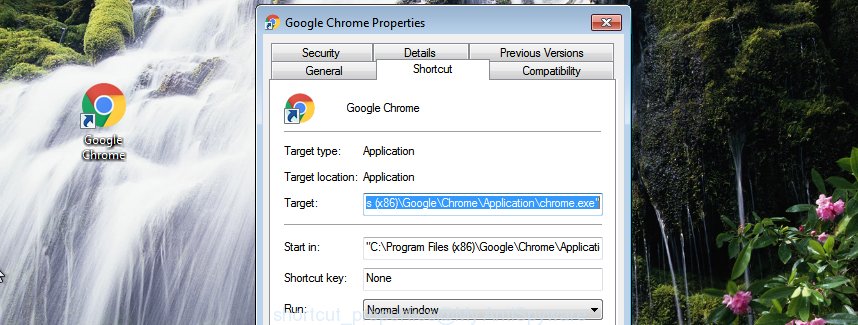
Normally, if the last word in the Target field is chrome.exe, iexplore.exe, firefox.exe. Be sure to pay attention to the extension, should be “exe”! All shortcuts which have been changed by adware such as Microsoft.com.cdn.pcsaver3.win usually point to .bat, .cmd or .url files instead of .exe like below

Another variant, an address has been added at the end of the line. In this case the Target field looks like …Application\chrome.exe” http://site.address as on the image below.

In order to fix a shortcut, you need to insert right path to the Target field or remove an address (if it has been added at the end). You can use the following information to fix your shortcuts which have been altered by adware.
| Chrome | C:\Program Files (x86)\Google\Chrome\Application\chrome.exe |
| C:\Program Files\Google\Chrome\Application\chrome.exe | |
| Firefox | C:\Program Files\Mozilla Firefox\firefox.exe |
| Microsoft Internet Explorer | C:\Program Files (x86)\Internet Explorer\iexplore.exe |
| C:\Program Files\Internet Explorer\iexplore.exe | |
| Opera | C:\Program Files (x86)\Opera\launcher.exe |
| C:\Program Files\Opera\launcher.exe |
Once is finished, press OK to save changes. Repeat the step for all browsers which are rerouted to the Microsoft.com.cdn.pcsaver3.win annoying web site.
How to automatically delete Microsoft.com.cdn.pcsaver3.win pop-up scam
Many antivirus companies have created programs that allow detect ad supported software and thereby delete Microsoft.com.cdn.pcsaver3.win from the Firefox, Google Chrome, Internet Explorer and Microsoft Edge browsers. Below is a a few of the free programs you may want to use. Your system can have a lot of potentially unwanted programs, adware and hijacker infections installed at the same time, so we recommend, if any unwanted or malicious program returns after restarting the computer, then launch your personal computer into Safe Mode and use the antimalware tool once again.
Run Zemana Anti-malware to delete Microsoft.com.cdn.pcsaver3.win
You can remove Microsoft.com.cdn.pcsaver3.win pop up scam automatically with a help of Zemana Anti-malware. We recommend this malicious software removal tool because it can easily get rid of browser hijackers, PUPs, ad supported software which reroutes your internet browser to Microsoft.com.cdn.pcsaver3.win web-page with all their components such as folders, files and registry entries.
Download Zemana Anti-Malware (ZAM) from the following link and save it directly to your Windows Desktop.
164752 downloads
Author: Zemana Ltd
Category: Security tools
Update: July 16, 2019
When the downloading process is finished, close all windows on your PC system. Further, launch the setup file called Zemana.AntiMalware.Setup. If the “User Account Control” prompt pops up as shown below, click the “Yes” button.

It will open the “Setup wizard” that will allow you install Zemana on the PC. Follow the prompts and do not make any changes to default settings.

Once installation is finished successfully, Zemana Free will automatically run and you can see its main window as shown on the image below.

Next, press the “Scan” button to perform a system scan with this utility for the adware that causes internet browsers to display misleading Microsoft.com.cdn.pcsaver3.win pop up. While the utility is scanning, you can see how many objects and files has already scanned.

As the scanning ends, Zemana Anti Malware (ZAM) will show a scan report. Review the results once the tool has finished the system scan. If you think an entry should not be quarantined, then uncheck it. Otherwise, simply click “Next” button.

The Zemana will delete adware which developed to display misleading Microsoft.com.cdn.pcsaver3.win pop up warning within your web browser. After finished, you may be prompted to reboot your personal computer.
Use Malwarebytes to remove Microsoft.com.cdn.pcsaver3.win pop up warning
You can remove Microsoft.com.cdn.pcsaver3.win pop-up warning automatically with a help of Malwarebytes Free. We suggest this free malware removal utility because it may easily remove browser hijacker infections, ad-supported software, potentially unwanted software and toolbars with all their components such as files, folders and registry entries.
Download MalwareBytes Anti-Malware (MBAM) by clicking on the following link.
327018 downloads
Author: Malwarebytes
Category: Security tools
Update: April 15, 2020
After the download is complete, close all windows on your system. Further, launch the file named mb3-setup. If the “User Account Control” prompt pops up as on the image below, click the “Yes” button.

It will open the “Setup wizard” which will allow you install MalwareBytes on the machine. Follow the prompts and do not make any changes to default settings.

Once install is complete successfully, click Finish button. Then MalwareBytes will automatically start and you can see its main window as shown on the screen below.
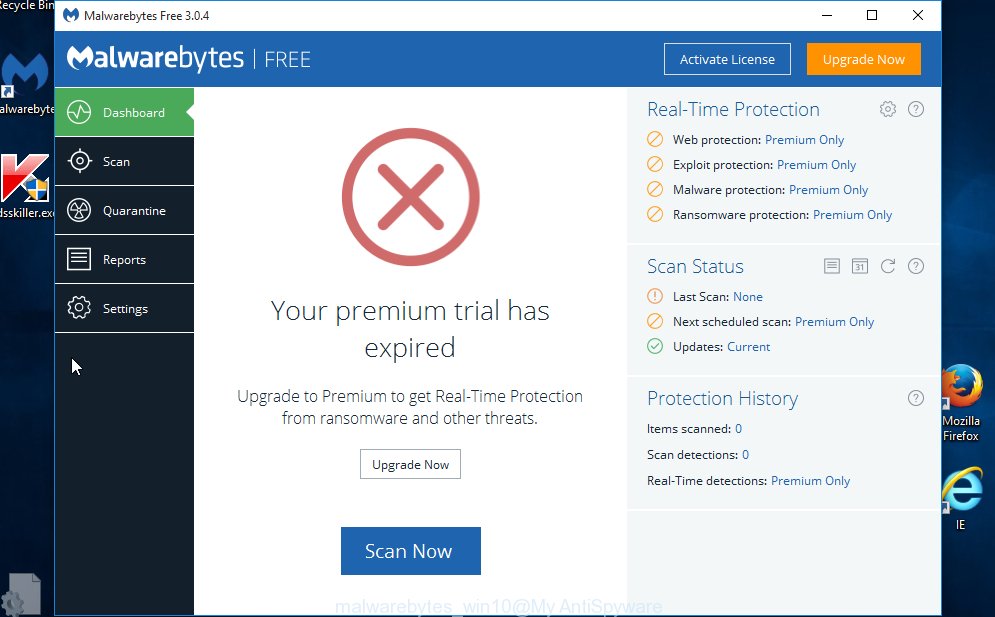
Next, press the “Scan Now” button to perform a system scan for the adware which made to show misleading Microsoft.com.cdn.pcsaver3.win pop up scam within your browser. Depending on your computer, the scan can take anywhere from a few minutes to close to an hour. When a threat is found, the number of the security threats will change accordingly. Wait until the the scanning is done.
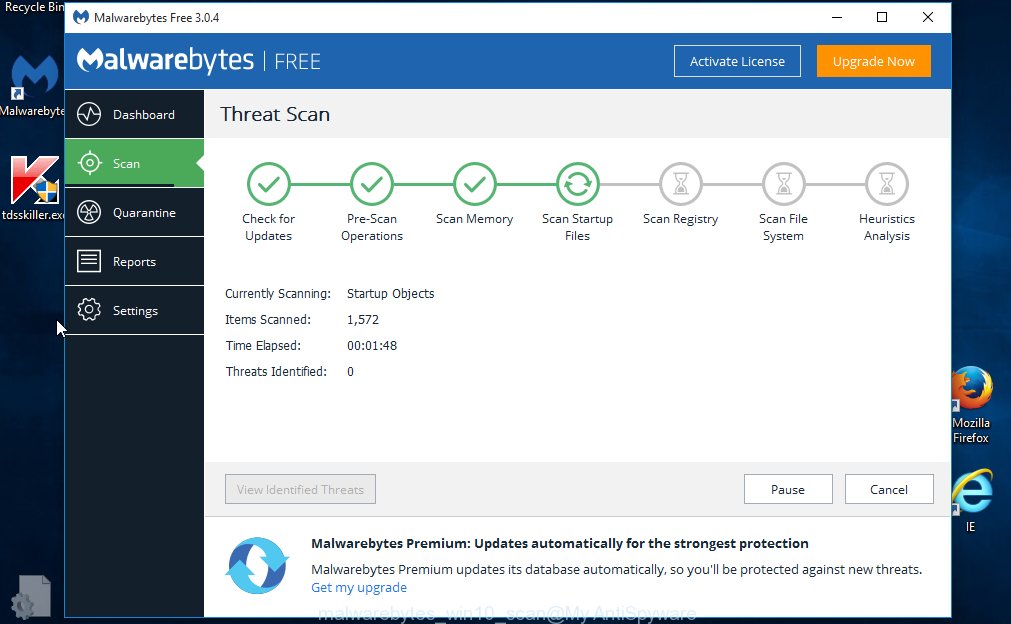
After the scan get completed, the results are displayed in the scan report. When you are ready, press “Quarantine Selected” button.

The MalwareBytes Free will delete adware that made to display misleading Microsoft.com.cdn.pcsaver3.win pop-up within your internet browser. Once the cleaning process is finished, you can be prompted to restart your PC. We advise you look at the following video, which completely explains the procedure of using the MalwareBytes Anti-Malware to remove browser hijacker infections, adware and other malware.
Delete Microsoft.com.cdn.pcsaver3.win pop-up scam and malicious extensions with AdwCleaner
If MalwareBytes antimalware or Zemana Free cannot delete this adware, then we suggests to use the AdwCleaner. AdwCleaner is a free removal tool for hijackers, PUPs, toolbars and adware that cause misleading Microsoft.com.cdn.pcsaver3.win pop-up to appear.
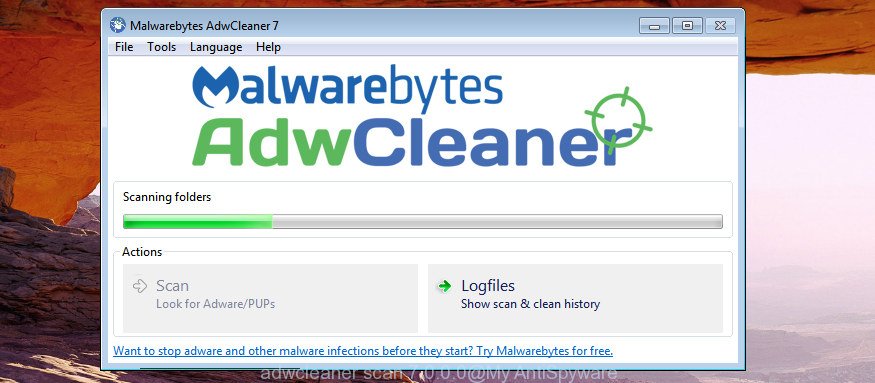
- Download AdwCleaner by clicking on the following link. Save it to your Desktop so that you can access the file easily.
AdwCleaner download
225518 downloads
Version: 8.4.1
Author: Xplode, MalwareBytes
Category: Security tools
Update: October 5, 2024
- Once the download is finished, double click the AdwCleaner icon. Once this utility is started, press “Scan” button . AdwCleaner tool will start scanning the whole machine to find out adware which shows misleading Microsoft.com.cdn.pcsaver3.win popup warning on your computer. This procedure can take quite a while, so please be patient. When a threat is found, the number of the security threats will change accordingly.
- As the scanning ends, AdwCleaner will open a list of all threats detected by the scan. When you are ready, click “Clean” button. It will open a prompt, click “OK”.
These few simple steps are shown in detail in the following video guide.
How to block Microsoft.com.cdn.pcsaver3.win pop-up
By installing an ad blocking application such as AdGuard, you are able to block Microsoft.com.cdn.pcsaver3.win, autoplaying video ads and get rid of a ton of distracting and intrusive ads on web pages.
Installing the AdGuard ad-blocker program is simple. First you will need to download AdGuard from the following link. Save it on your Windows desktop.
26829 downloads
Version: 6.4
Author: © Adguard
Category: Security tools
Update: November 15, 2018
Once downloading is finished, double-click the downloaded file to run it. The “Setup Wizard” window will show up on the computer screen as displayed in the figure below.

Follow the prompts. AdGuard will then be installed and an icon will be placed on your desktop. A window will show up asking you to confirm that you want to see a quick guidance as displayed in the following example.

Press “Skip” button to close the window and use the default settings, or click “Get Started” to see an quick instructions which will help you get to know AdGuard better.
Each time, when you launch your PC, AdGuard will start automatically and stop pop-up ads, web-pages such Microsoft.com.cdn.pcsaver3.win, as well as other malicious or misleading web-sites. For an overview of all the features of the program, or to change its settings you can simply double-click on the AdGuard icon, that is located on your desktop.
Prevent Microsoft.com.cdn.pcsaver3.win pop-up from installing
The adware is bundled within some freeware. So always read carefully the setup screens, disclaimers, ‘Terms of Use’ and ‘Software license’ appearing during the install procedure. Additionally pay attention for additional applications which are being installed along with the main program. Ensure that you unchecked all of them! Also, use an ad-blocker application that will help to block malicious, misleading, illegitimate or untrustworthy web-sites.
To sum up
Now your machine should be clean of the adware that displays misleading Microsoft.com.cdn.pcsaver3.win pop up scam on your PC system. Delete AdwCleaner. We suggest that you keep Zemana (to periodically scan your machine for new adwares and other malware) and AdGuard (to help you stop intrusive ads and malicious pages). Moreover, to prevent adwares, please stay clear of unknown and third party applications, make sure that your antivirus program, turn on the option to scan for PUPs (potentially unwanted programs).
If you need more help with Microsoft.com.cdn.pcsaver3.win pop-up related issues, go to our Spyware/Malware removal forum.




















